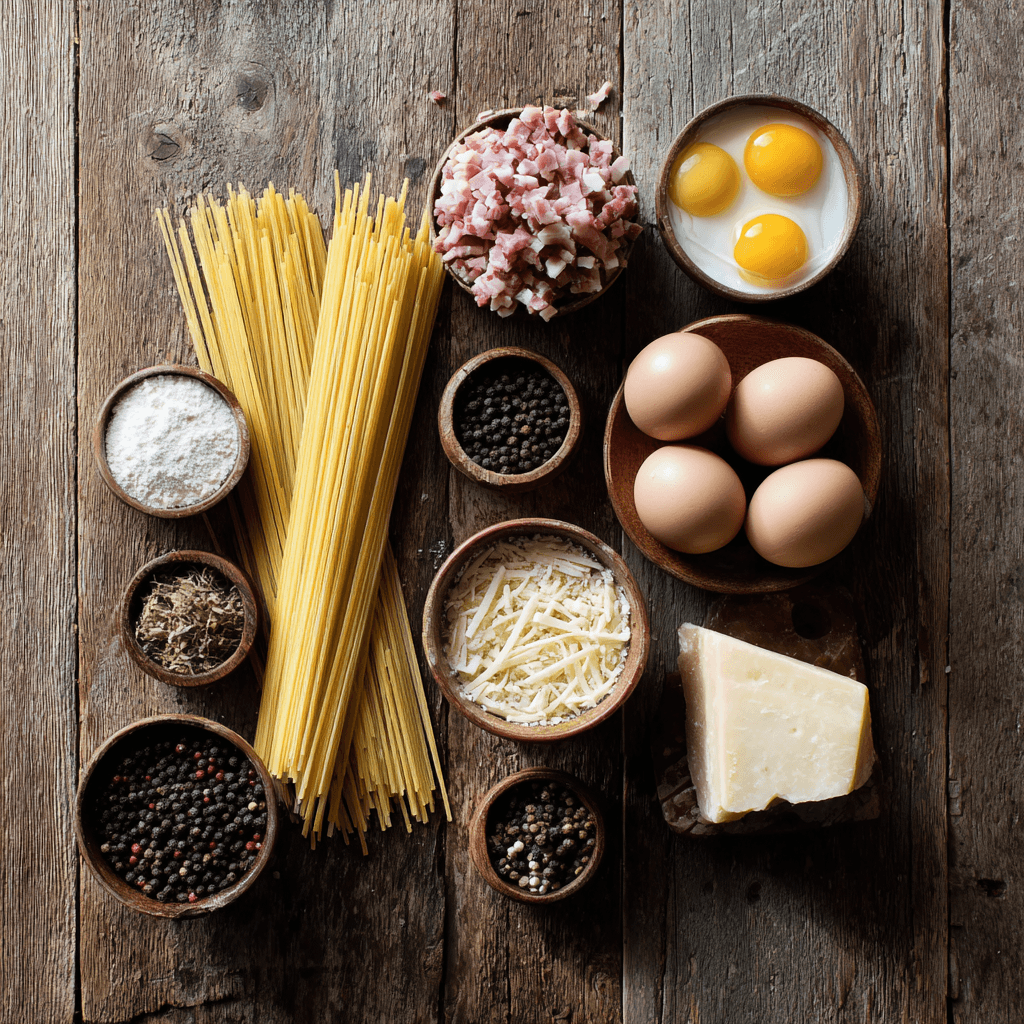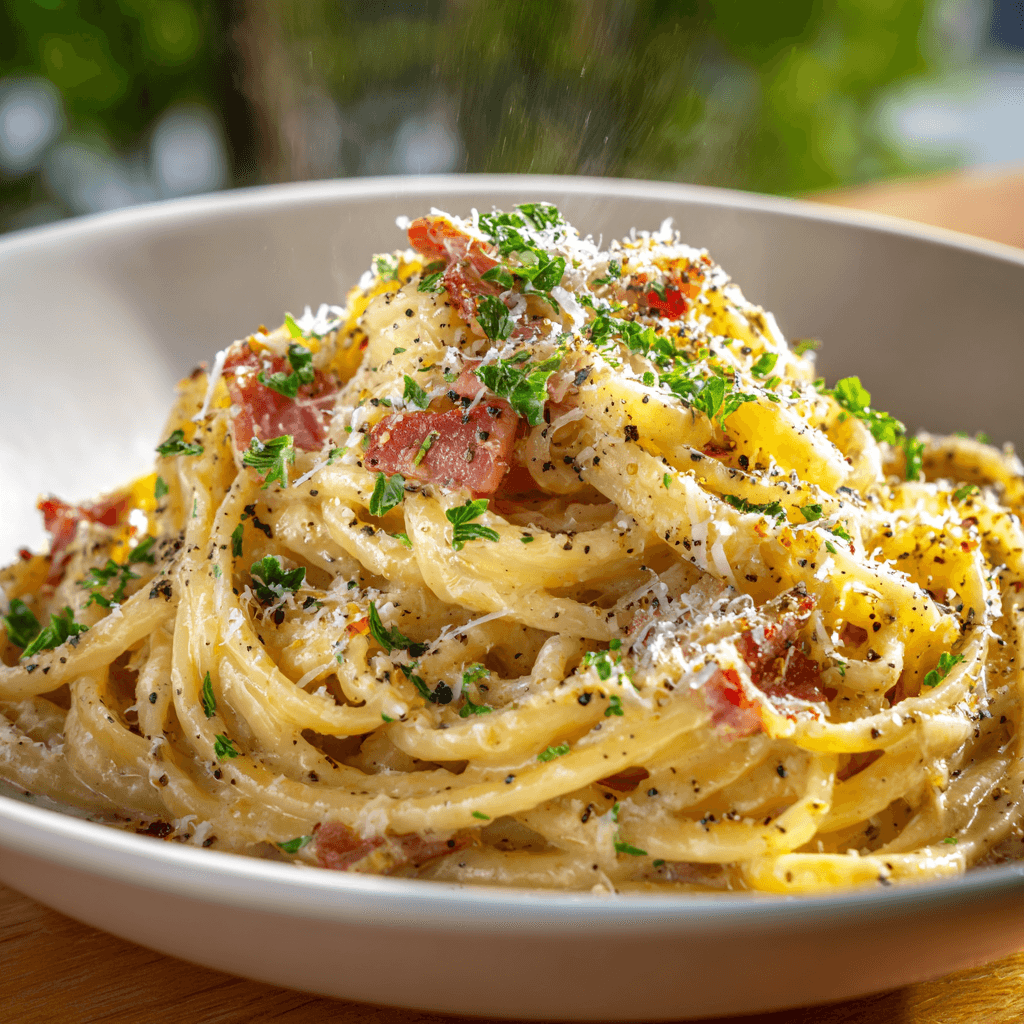Table of Contents
Gordon Ramsay Carbonara might seem simple, but after 15 years in the firehouse kitchen feeding hungry crews, I learned that the simplest dishes often hide the biggest challenges. One rushed evening, I watched a rookie firefighter turn what should have been creamy carbonara into what looked like cheesy scrambled eggs with pasta – a mistake that taught me the critical importance of temperature control. According to the FDA’s food safety guidelines, proper temperature management isn’t just about technique, it’s about safety. This Italian pasta classic demands respect, patience, and the right approach to achieve that signature silky texture that made Gordon Ramsay’s version legendary.
Why This Gordon Ramsay Carbonara Recipe Works (And Where Most Go Wrong)
The genius behind Gordon Ramsay Carbonara lies in understanding three fundamental principles that separate restaurant-quality results from amateur attempts. First, temperature control is absolutely critical – the pasta water should be hot enough to cook the eggs gently but not so hot that it scrambles them instantly. Most home cooks add the egg mixture to pasta that’s still screaming hot, creating that dreaded scrambled egg texture.
Second, the timing of combining ingredients follows a precise sequence that can’t be rushed. The rendered guanciale fat must be at the perfect temperature when you add the pasta water to create an emulsion, similar to how we maintained precise timing during emergency responses. Third, the constant motion and gradual temperature reduction allows the proteins to set properly while creating that signature glossy finish. According to Serious Eats’ food science research, this emulsification process is what transforms simple ingredients into culinary magic.
Ingredients That Actually Matter for Gordon Ramsay Carbonara

The beauty of Gordon Ramsay Carbonara lies in its simplicity, but each ingredient plays a crucial role that can’t be compromised. Guanciale, the cured pork jowl, provides the essential fat and flavor base – pancetta works as a substitute, but bacon should be your last resort due to its smoking process altering the flavor profile. Look for guanciale that’s firm to the touch with a good ratio of fat to meat, and always slice it thick enough to render properly without becoming crispy.
Pecorino Romano cheese must be freshly grated – never use pre-grated cheese as it contains anti-caking agents that prevent proper melting and emulsification. The eggs should be fresh and at room temperature; cold eggs won’t incorporate smoothly and increase the risk of clumping. For pasta, choose a shape with ridges like rigatoni or tonnarelli that holds the sauce effectively. Quality matters here – fresh pasta cooks faster and requires even more precise timing, so dried pasta offers more forgiveness for beginners while still delivering excellent results.
Step-by-Step Instructions for Gordon Ramsay Carbonara
Preparation Phase
Start by bringing a large pot of salted water to boil – use enough salt that it tastes like seawater. While waiting, cut 200g of guanciale into thick matchsticks, about 1cm wide. In a large mixing bowl, whisk together 3 large egg yolks, 1 whole egg, and 100g of freshly grated Pecorino Romano until completely smooth. Never add the cheese gradually here – it must be incorporated all at once to prevent clumping.
Cooking the Guanciale
Heat a large heavy-bottomed pan over medium-low heat – no oil needed. Add the guanciale and cook slowly, stirring occasionally, for 8-10 minutes until the fat renders and the edges are golden but not crispy. Control your heat carefully – if the pan gets too hot, the rendered fat will burn and turn bitter. The goal is extracting maximum fat while keeping the meat tender.
Pasta and Assembly
Add 400g of pasta to the boiling water and cook until just under al dente – it will finish cooking in the pan. Reserve 200ml of starchy pasta water before draining. Work quickly but don’t panic – timing is crucial but manageable with practice. Add the drained pasta directly to the pan with guanciale over the lowest heat setting.
Remove the pan from heat completely and add a splash of pasta water. Toss vigorously for 30 seconds, then slowly pour the egg mixture over the pasta while constantly stirring with tongs. The residual heat will cook the eggs gently. Add pasta water gradually until you achieve a glossy, creamy consistency that coats each strand. If you see any signs of the eggs cooking too quickly, add cold pasta water immediately and remove from any heat source. Finish with freshly cracked black pepper and additional Pecorino Romano. This technique mirrors the careful monitoring we used for equipment temperatures in the firehouse – vigilance prevents disasters.
Pro-Tips That Change the Game
- Let your eggs come to room temperature for 30 minutes before cooking – cold eggs are more likely to seize when mixed with hot pasta
- Reserve extra pasta water and keep it warm in a separate pot – you’ll often need more than expected to achieve the perfect consistency
- Use a wooden spoon or tongs, never a whisk, when combining the eggs with pasta to prevent breaking the emulsion
- The pan should be warm to the touch but not hot when adding the egg mixture – test with your hand held 6 inches above the surface
- Grate your Pecorino Romano on the finest setting possible – larger pieces won’t melt smoothly and create a grainy texture
- Serve immediately on warmed plates – Gordon Ramsay Carbonara waits for no one and will thicken quickly as it cools
Storage & Leftovers for Gordon Ramsay Carbonara
Carbonara is best enjoyed immediately, but leftovers can be stored in the refrigerator for up to 2 days in an airtight container. The sauce will thicken significantly when cold, which is normal. To reheat, add a splash of milk or cream to a cold pan with the carbonara and warm over the lowest heat setting, stirring gently until heated through. Never microwave carbonara as the high heat will scramble the eggs and ruin the texture.
For food safety, ensure leftovers are cooled within 2 hours of cooking and stored at 40°F or below. According to USDA guidelines for pasta dishes, egg-based sauces should be consumed within 3-4 days maximum. If reheating isn’t successful and the sauce appears broken, you’re better off starting fresh – some dishes simply don’t forgive shortcuts.

Gordon Ramsay Carbonara
Ingredients
Equipment
Method
- 1️⃣ Bring a large pot of salted water to boil – use enough salt that it tastes like seawater. While waiting, cut 200g of guanciale into thick matchsticks, about 1cm wide.
- 2️⃣ In a large mixing bowl, whisk together 3 large egg yolks, 1 whole egg, and 100g of freshly grated Pecorino Romano until completely smooth. Never add the cheese gradually here – it must be incorporated all at once to prevent clumping.
- 3️⃣ Heat a large heavy-bottomed pan over medium-low heat – no oil needed. Add the guanciale and cook slowly, stirring occasionally, for 8-10 minutes until the fat renders and the edges are golden but not crispy.
- 4️⃣ Add 400g of pasta to the boiling water and cook until just under al dente – it will finish cooking in the pan. Reserve 200ml of starchy pasta water before draining.
- 5️⃣ Add the drained pasta directly to the pan with guanciale over the lowest heat setting. Remove the pan from heat completely and add a splash of pasta water. Toss vigorously for 30 seconds.
- 6️⃣ Slowly pour the egg mixture over the pasta while constantly stirring with tongs. The residual heat will cook the eggs gently. Add pasta water gradually until you achieve a glossy, creamy consistency that coats each strand.
- 7️⃣ Finish with freshly cracked black pepper and additional Pecorino Romano. Serve immediately on warmed plates – carbonara waits for no one and will thicken quickly as it cools.
Nutrition
Notes
Tried this recipe?
Let us know how it was!Frequently Asked Questions About Gordon Ramsay Carbonara
What is the golden rule of cooking a carbonara?
The golden rule is temperature control – never let the eggs get too hot or they’ll scramble instead of creating a creamy sauce. Remove the pan from heat before adding the egg mixture and use the residual heat from the pasta and rendered fat to gently cook the eggs while constantly stirring. This Gordon Ramsay Carbonara technique ensures silky results every time.
What are some interesting facts about carbonara?
Carbonara likely originated in Rome during World War II, possibly created by Italian cooks using American military rations of eggs and bacon. The name comes from “carbonari” meaning charcoal burners, though whether it refers to the black pepper or the workers who ate it remains debated. Traditional Gordon Ramsay Carbonara uses only five ingredients and never includes cream, despite many restaurant versions.
Did Gordon Ramsay ever apologize?
Yes, Gordon Ramsay has publicly apologized several times throughout his career, including for harsh treatment of staff in early years and various controversial statements. He’s acknowledged that his intense kitchen style, while driving excellence, sometimes crossed professional boundaries. His approach to teaching techniques like carbonara has evolved to be more encouraging while maintaining high standards.
What are the 5 ingredients in carbonara?
Traditional carbonara contains exactly five ingredients: pasta, guanciale (cured pork jowl), eggs, Pecorino Romano cheese, and freshly ground black pepper. No cream, garlic, peas, or other additions appear in authentic versions. This simplicity is what makes Gordon Ramsay Carbonara both challenging and rewarding – there’s nowhere to hide imperfect technique when using so few components. Each ingredient must be perfect quality.
Mastering Gordon Ramsay Carbonara takes practice, but understanding these fundamental techniques will transform your results from the very first attempt. Trust the process, respect the ingredients, and remember that even professional chefs had to learn these lessons through experience.
Stay safe,
Jack Sullivan


